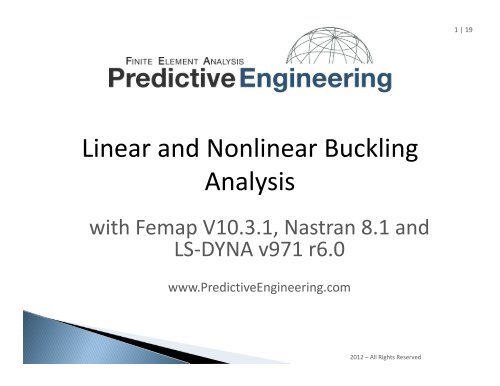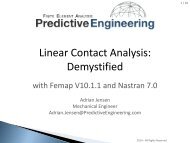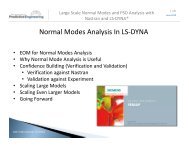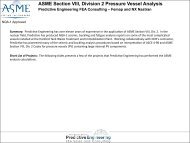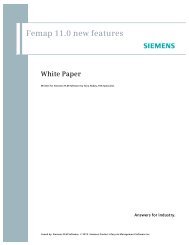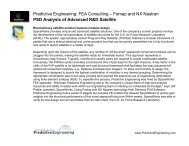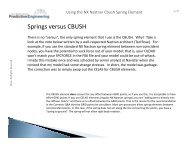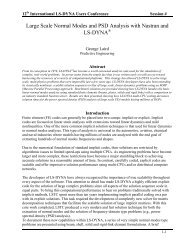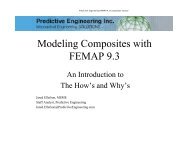Linear and Nonlinear Buckling Analysis - Predictive Engineering
Linear and Nonlinear Buckling Analysis - Predictive Engineering
Linear and Nonlinear Buckling Analysis - Predictive Engineering
You also want an ePaper? Increase the reach of your titles
YUMPU automatically turns print PDFs into web optimized ePapers that Google loves.
1| 19<br />
<strong>Linear</strong> <strong>and</strong> <strong>Nonlinear</strong> <strong>Buckling</strong><br />
<strong>Analysis</strong><br />
with Femap V10.3.1, Nastran 8.1 <strong>and</strong><br />
LS‐DYNA v971 r6.0<br />
www.<strong>Predictive</strong><strong>Engineering</strong>.com<br />
2012 –All Rights Reserved
<strong>Linear</strong> <strong>and</strong> <strong>Nonlinear</strong> <strong>Buckling</strong> <strong>Analysis</strong> with NX Nastran <strong>and</strong> LS‐DYNA<br />
2| 19<br />
Introduction<br />
Calculating the buckling force for a ideal column is quite simple. As long as you know the length, second moment of inertia <strong>and</strong><br />
elastic modulus of the beam, you can calculate the force by h<strong>and</strong>. What if you don’t have an ideal column. What if you don’t have<br />
column or beam geometry at all but buckling is still a concern for your design?<br />
This white paper will walk you through the NX Nastran <strong>Linear</strong> <strong>Buckling</strong> <strong>Analysis</strong>. Additionally, the paper will show you how to<br />
validate your linear buckling analysis with a non‐liner static analysis.<br />
2012 –All Rights Reserved
<strong>Linear</strong> <strong>and</strong> <strong>Nonlinear</strong> <strong>Buckling</strong> <strong>Analysis</strong> with NX Nastran <strong>and</strong> LS‐DYNA<br />
3| 19<br />
2012 –All Rights Reserved<br />
Shown above are the cross sectional properties for the beam we will be analyzing. Given a length of<br />
300”, the critical load is 57,562 lbf.
<strong>Linear</strong> <strong>and</strong> <strong>Nonlinear</strong> <strong>Buckling</strong> <strong>Analysis</strong> with NX Nastran <strong>and</strong> LS‐DYNA<br />
4| 19<br />
Boundary Conditions<br />
The beam is pinned at both ends. The vertical degree of<br />
freedom is released at the upper constraint. Rotation<br />
about the vertical axis is prevented at the lower<br />
constraint. An arbitrary load is applied to the upper most<br />
node.<br />
2012 –All Rights Reserved
<strong>Linear</strong> <strong>and</strong> <strong>Nonlinear</strong> <strong>Buckling</strong> <strong>Analysis</strong> with NX Nastran <strong>and</strong> LS‐DYNA<br />
5| 19<br />
2012 –All Rights Reserved<br />
The title of the Output Set will include a load factor<br />
value. This factor multiplied by the applied load is equal<br />
to the critical load. 5.751*10,000lbf = 57,510 lbf,<br />
correlating to the h<strong>and</strong> calculation of 57,562 within<br />
0.1%.
<strong>Linear</strong> <strong>and</strong> <strong>Nonlinear</strong> <strong>Buckling</strong> <strong>Analysis</strong> with NX Nastran <strong>and</strong> LS‐DYNA<br />
6| 19<br />
Additional Results<br />
The linear buckling analysis returns two output sets.<br />
The first output set (titled “NX NASTRAN Case 1” by<br />
default) is simply a linear elastic analysis of the<br />
boundary conditions specified in the analysis.<br />
2012 –All Rights Reserved<br />
The second output set (in this case, titled “Eigenvalue<br />
5.750754”) shows the first mode shape of the structure<br />
with the given constraints. The peak deflection of the<br />
structure is set to 1. Stresses are reaction forces<br />
correspond to the deflection of the mode shape. The<br />
only valuable piece of quantitative information that<br />
comes from this output set is the load factor value.
<strong>Linear</strong> <strong>and</strong> <strong>Nonlinear</strong> <strong>Buckling</strong> <strong>Analysis</strong> with NX Nastran <strong>and</strong> LS‐DYNA<br />
7| 19<br />
Additional Resources<br />
A similar example of Classic Euler <strong>Buckling</strong><br />
can be found in the NX Nastran User’s<br />
Guide.<br />
2012 –All Rights Reserved
<strong>Linear</strong> <strong>and</strong> <strong>Nonlinear</strong> <strong>Buckling</strong> <strong>Analysis</strong> with NX Nastran <strong>and</strong> LS‐DYNA<br />
8| 19<br />
2012 –All Rights Reserved<br />
Verification<br />
More common than not, the solution cannot be verified<br />
with a h<strong>and</strong> calculation (this is why we are doing FEA,<br />
right?). The solution can be verified with the slightly trickier<br />
<strong>Nonlinear</strong> Static analysis. For this validation, the load has<br />
been increased to 100,000 lbf such that the critical load will<br />
be evaluated in the intermediate steps of the nonlinear<br />
analysis. Additionally, a small bending moment (Mx = 100<br />
in‐lbf) has been added to direct the model to the first<br />
buckling mode.
<strong>Linear</strong> <strong>and</strong> <strong>Nonlinear</strong> <strong>Buckling</strong> <strong>Analysis</strong> with NX Nastran <strong>and</strong> LS‐DYNA<br />
9| 19<br />
2012 –All Rights Reserved<br />
The non‐linear solution diverges at time = 0.5755. With the<br />
load increasing from 0 to 100,000 lbf as time increases<br />
from 0 to 1, this correlates to a load of 57,550 lbf.
<strong>Linear</strong> <strong>and</strong> <strong>Nonlinear</strong> <strong>Buckling</strong> <strong>Analysis</strong> with NX Nastran <strong>and</strong> LS‐DYNA<br />
10 | 19<br />
0.1<br />
Euler Beam <strong>Buckling</strong>: Defelction vs Load<br />
0.09<br />
0.085<br />
0.08<br />
0.09<br />
0.08<br />
Deflection (in)<br />
0.075<br />
0.07<br />
0.065<br />
2012 –All Rights Reserved<br />
Deflection (in)<br />
0.07<br />
0.06<br />
0.05<br />
0.04<br />
0.06<br />
0.055<br />
0.05<br />
57400 57450 57500 57550 57600<br />
Load (lbf)<br />
0.03<br />
0.02<br />
0.01<br />
10000 20000 30000 40000 50000 60000<br />
Load (lbf)<br />
To further illustrate the buckling load, the vertical deflection<br />
is plotted as a function of load. The point at which small<br />
increase in load results in a large increase in deflection is the<br />
buckling load.<br />
Additional data at the buckling load was acquired using the<br />
Arc‐Length Method option within the <strong>Analysis</strong> Manager,<br />
<strong>Nonlinear</strong> Control Options.<br />
“The arc‐length method should be used if the problem<br />
involves snap‐through or postbuckling deformation”<br />
–NX Nastran 7 Basic <strong>Nonlinear</strong> <strong>Analysis</strong> User’s Guide
<strong>Linear</strong> <strong>and</strong> <strong>Nonlinear</strong> <strong>Buckling</strong> <strong>Analysis</strong> with NX Nastran <strong>and</strong> LS‐DYNA<br />
11 | 19<br />
2012 –All Rights Reserved<br />
Once you are confident analyzing simple members for<br />
buckling with both the linear <strong>and</strong> nonlinear approach,<br />
move on to more complicated geometry. Above is an<br />
example from the NX Nastran H<strong>and</strong>book of <strong>Nonlinear</strong><br />
<strong>Analysis</strong> for an Imperfect Spherical Shell.
<strong>Linear</strong> <strong>and</strong> <strong>Nonlinear</strong> <strong>Buckling</strong> <strong>Analysis</strong> with NX Nastran <strong>and</strong> LS‐DYNA<br />
12 | 19<br />
2012 –All Rights Reserved<br />
A more advanced example of linear <strong>and</strong> nonlinear buckling is provided here. A simple<br />
thin walled aluminum cylinder (i.e. beer can) is modeled with plate elements. The<br />
load case is an equally distributed axial force. The beer can is carefully constrained to<br />
avoid end effects.
<strong>Linear</strong> <strong>and</strong> <strong>Nonlinear</strong> <strong>Buckling</strong> <strong>Analysis</strong> with NX Nastran <strong>and</strong> LS‐DYNA<br />
13 | 19<br />
With a perfect cylinder, the Eigenvalue buckling solution indicates that the cylinder should buckle at a load of 73 lbf (0.073*1,000 lbf). The<br />
nonlinear solution just compresses the cylinder. In the perfect numerical world, this makes perfect sense.<br />
2012 –All Rights Reserved
<strong>Linear</strong> <strong>and</strong> <strong>Nonlinear</strong> <strong>Buckling</strong> <strong>Analysis</strong> with NX Nastran <strong>and</strong> LS‐DYNA<br />
14 | 19<br />
A common trick to initiate buckling in perfect geometry / mesh, is to take the buckled mode shape <strong>and</strong> map it onto the mesh. This can be<br />
done using a Femap API within the Custom Tools > PostProcessing > Nodes Move By Deform with Options. We have scaled the mode<br />
shape by 0.001. The concept is that you just want to perturb the perfect geometry such that it will start to buckle. It should be noted that<br />
the two solutions correlate within 2%.<br />
2012 –All Rights Reserved
<strong>Linear</strong> <strong>and</strong> <strong>Nonlinear</strong> <strong>Buckling</strong> <strong>Analysis</strong> with NX Nastran <strong>and</strong> LS‐DYNA<br />
15 | 19<br />
If we adjust the constraints to restrict horizontal movement on the top edge <strong>and</strong> to pin the bottom edge, the buckling force increases to<br />
around 200 lbf. These constraints simulate a real beer can more closely. This seems reasonable for the support weight of an idealized beer<br />
can.<br />
2012 –All Rights Reserved
<strong>Linear</strong> <strong>and</strong> <strong>Nonlinear</strong> <strong>Buckling</strong> <strong>Analysis</strong> with NX Nastran <strong>and</strong> LS‐DYNA<br />
16 | 19<br />
A nonlinear analysis provides the buckling stress at the point of collapse. The utility of the geometrically nonlinear approach is that one<br />
can gain insight into the structure prior to its buckled condition. The image on the left shows the can with a load of 200 lbf (0.2*1,000 lbf)<br />
while the image on the right shows the buckled condition is at 216 lbf. It is also useful to note that if the material had a yield strength in<br />
excess of 42,000 psi, the buckling behavior would be completely independent of material nonlinear effects.<br />
2012 –All Rights Reserved
<strong>Linear</strong> <strong>and</strong> <strong>Nonlinear</strong> <strong>Buckling</strong> <strong>Analysis</strong> with NX Nastran <strong>and</strong> LS‐DYNA<br />
17 | 19<br />
Another confirmation using LS‐DYNA gave similar results for the beer can with buckling occurring around 190 lbf. However, the question<br />
that arises whether this buckled shape is really stable or an artifact of our boundary conditions. In modeling, a model is just a model <strong>and</strong><br />
can’t really be trusted unless it has been validated with a test.<br />
2012 –All Rights Reserved
<strong>Linear</strong> <strong>and</strong> <strong>Nonlinear</strong> <strong>Buckling</strong> <strong>Analysis</strong> with NX Nastran <strong>and</strong> LS‐DYNA<br />
18 | 19<br />
In this example, the nodes of the can were tweaked, or perturbed, to create a completely r<strong>and</strong>om surface. This operation was done within<br />
LS‐DYNA <strong>and</strong> allows one to specify a completely r<strong>and</strong>om displacement of the nodes. Results indicate that the can would buckle right<br />
around 190 lbf.<br />
2012 –All Rights Reserved
19 | 19<br />
www.<strong>Predictive</strong><strong>Engineering</strong>.com<br />
2012 –All Rights Reserved


